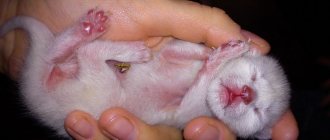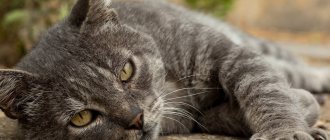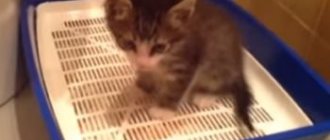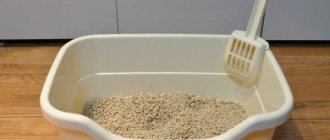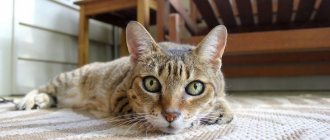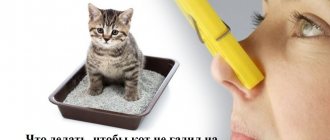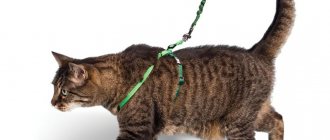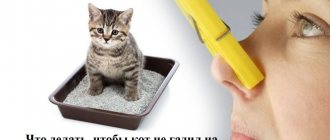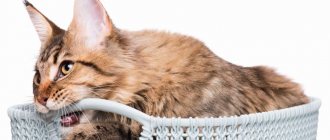Why monitor the development of newborn kittens?
It is very important to monitor how newborn kittens develop and know how best to care for babies at different stages of their growth. This will help get rid of many problems associated with animal health.
During the first three weeks of kittens' lives, mother cats themselves feed and care for them. However, control over the full and timely development of small pets is the responsibility of the owner. To do this, you need to regularly weigh the kittens, and also know when they open their eyes, when their first teeth are cut, when they begin to hear, walk and eat solid food.
Mother cat takes care of newborn kittens herself
Scottish Shorthair cat - features of the breed
Before getting an animal, especially a blue-blooded cat, you should know all the characteristics of the breed.
It just so happens that when choosing a pet, potential owners pay attention only to the positive aspects of the breed, without taking into account the nuances of care and possible problems
The Scottish cat is a very common breed. Unfortunately, the more popular the breed, the more amateur breeders sell kittens with poor genetics. Such kittens are sold cheaper than their counterparts with documents. In addition, many potential owners choose pets solely based on appearance, for example, the shape of the ears or color.
The Scottish cat breed is divided into two large groups:
- Shorthair – stay and fold variety.
- Longhair (Highland) - stay and fold variety. Note that, by and large, Highlands are a completely different breed that has common roots with Scottish Shorthair cats.
Scottish cats are sociable, independent, clean and attractive. Cats with good heredity rarely develop health problems.
Amateur-bred animals often suffer from food allergies, skin problems, diseases of the musculoskeletal system and the cardiovascular system. Naturally, among shorthaired Scots, Fold kittens are more popular.
Scottish Fold kittens - features
Scottish fold kittens (folds), in theory, differ from their straight-eared counterparts only in the shape of their ears. In practice, everything is much sadder. Fold kittens are in high demand, so unscrupulous sellers use various tricks to increase their income. In the best case, kittens' ears are glued or pressed to the head with tight bandages. The ear cartilage does not form correctly and the kitten is called a fold. In this case, nothing threatens the animal’s health, except that there is a risk of developing chronic otitis media.
In the worst case, unscrupulous breeders breed two fold-eared parents. Kittens from such mating are disabled from birth. It is only a matter of time before animals develop malformations of the musculoskeletal system.
Some kittens from these litters are born with deformed hind legs and are unable to walk. In others, the deformities may appear later, leading to chronic pain or paralysis of the hind limbs. Unfortunately, if a kitten is born from a fold + fold mating, no amount of care or even the highest quality nutrition will change the situation.
Stages of kitten development by month
The stages of growth and maturation of a kitten, from the moment of birth to one year, are associated with certain patterns. All kittens go through the same stages of development over the course of days and months.
First week
Kittens are born with their eyes closed and hear almost nothing. They are covered with light fluff; the most important thing for them during this period is warmth and milk.
In the first weeks, kittens' immune systems are largely supported by mother's milk. It provides their body with the proteins necessary for development. The weight of newborn kittens rarely exceeds 100 grams; within a week they gain weight from 10 to 30 grams per day.
Most of the day, approximately 90% of the time, kittens sleep. They move only to crawl to the cat for milk and warmth. If they are cold or want to eat, they call the cat with a loud squeak.
Kittens are born with primary reflexes
Observing the development of small kittens day by day, it can be noted that on days 5-8 kittens develop hearing. Since kittens are just learning to respond to sound, the room where they are should be relatively quiet.
After the 5th day of life, the umbilical cord dries out in kittens. The cat should constantly lick the cubs, giving a tummy massage, which helps stimulate the intestines.
There should be no drafts in the room where the cat and newborn kittens are located. If it is very cold, you can put a heating pad in the bed. Young kittens are very vulnerable to disease and infection.
Second and third weeks
On days 7-10, the eyes open. The process can take 2-3 days - at first there are narrow slits through which only the outlines of objects can be distinguished. The eyes are cloudy, blue and covered with a film. The eyes open completely by the 14th day.
Kittens' eyes open at 7-10 days
The speed of eye opening depends on several factors:
- by breed;
- from gestation period;
- on the health status of the mother and kittens.
In most cases, short-haired breeds develop faster than long-haired ones, and Oriental cats develop much faster than other cat breeds. For example, sphinxes (Canadian, Don) are often born with their eyes already slightly open, and on the 2-3rd day the eyes open completely. Siamese, Thai and Cornish Rex cats become sighted on days 3-6, Siberian and Persian cats on days 5-9, and British cats on days 6-10.
Another indicator is the gestation period of the kittens. If kittens are born at 68-71 days, then perhaps they will be born with their eyes already open, or will open them in a much shorter time.
If the kittens are healthy, eat well, and the cat devotes enough time to them, then the eyes, as a rule, open in a timely manner. A delay may indicate that the mother cat has some kind of virus, or that the kitten has developmental disorders. If more than 10 days have passed and the eyes are still closed and there is some discharge from under the eyelids, you need to consult a veterinarian.
In 2-week-old kittens, the fur grows and becomes thicker, and the undercoat begins to grow. At this age, kittens' susceptibility to temperature changes decreases, however, they are still vulnerable. The kittens' weight doubles. They hear much better, but still have difficulty identifying the source of sound.
A kitten at the age of 3 weeks continues to actively gain weight; its vision is not yet so sharp, so when it crawls, it can bump into objects. In the third week, the kittens make their first attempts to get out of the bed. During this period, baby teeth begin to emerge.
Three-week-old kittens begin to move actively
Kitten at 1 month
At 4 weeks of age, kittens begin to interact more and lick each other's fur. They begin to actively run, play, and adopt the skills of their mother. At this time, you can place a tray next to the bed on which the kittens sleep so that they begin to get used to it.
By the age of one month, the kitten has 26 milk teeth and sometimes bites the cat's nipple, causing pain. If maternal feeding stops by the age of one month, it is advisable to purchase a cat's milk substitute, since the kitten's body is not yet fully formed. At this stage, complementary foods and clean water are also introduced into the diet.
The bones of one-month-old kittens become stronger, they can already be picked up, stroked and played with more often so that they begin to get used to the person and his smell. This is also a good time to prevent worms.
By the age of one and a half months, the kitten already knows how to wash itself, hunt, go to the litter box, and eat solid food. At this time, you can purchase a scratching post, as the kitten begins to produce sharp claws.
Development of a kitten from birth to 1.5 months
Kitten at 2 months
Upon reaching the age of 2 months, kittens usually stop receiving mother's milk and switch to self-feeding.
At 2 months, kittens’ vision is fully formed, hearing and sense of smell are well developed. The kittens' eyes cease to be cloudy and acquire their natural shade. However, there are specific breeds in which the eye color does not change, for example, Siamese, Thai, Polynesian and British breeds.
The fur changes color intensity, the pattern appears, the lines become clear. This happens slowly and gradually, and therefore is not immediately noticed by others.
During this period, the kitten should be shown to a veterinarian for the first time, who will record the level of development and health status of the animal. At the age of 2.5 months, the kitten must receive its first vaccinations against viral diseases. The second vaccination is given after 3-4 weeks.
Two months you need to take the kitten to the veterinarian for examination and vaccination
Kitten at 3 months
In the third month of life, all processes begin to slow down a little, and the kitten’s character begins to emerge. He becomes completely independent and responds to his nickname.
A three-month-old kitten has a well-developed musculoskeletal system; he already knows where the bowl is and where the tray is. At this age, the kitten becomes faster and bolder. He is actively exploring his home, so it is necessary to ensure his complete safety. You should protect the kitten from chemicals, detergents, medications, poisonous plants, remove small objects - needles, pins, push pins, close electrical outlets.
A booster vaccination can be given at 12 weeks of age. At this time, it is also necessary to carry out repeated deworming, provided that it was first carried out at the age of 4-6 weeks.
By 3.5 months, the kitten’s character has already been formed, it sees and hears excellently, eats natural or industrial ready-made food, and goes to the litter tray. You can already visually distinguish a cat from a cat.
If you plan to give away or sell a kitten, then the age of 3-3.5 months is an ideal option for changing the owner.
You need to play with a small kitten every day
Kitten at 4 months
At 4 months, a kitten is already considered a teenager. During this period, his claws are trimmed for the first time and he is taught all hygiene procedures. To maintain proper development, you need to spend as much time as possible playing with the kitten; it is recommended to pick it up more often, show care and groom it daily so that the kitten feels comfortable when communicating with a person.
Milk teeth in kittens begin to change to molars; this happens gradually and often unnoticed by the owner. Kittens swallow most of their baby teeth with food.
At 4 months, a kitten needs to have its nails trimmed for the first time.
Kitten at 5 months
At 5 months, the kitten’s appearance gradually changes, its body increases in size, its muzzle and tail lengthen, its legs stretch. He already looks more like an adult cat, he is less interested in toys, he sleeps more and strives to communicate with people.
Sixth month of life
At the age of 6 months, the kitten reaches its adult size. Most kittens begin puberty during this period. The timing of puberty can shift from 4-5 months to 11-12 months of age. Puberty is affected by:
- Breed. Siamese, Thai, Burmese, and Oriental varieties ripen earlier.
- Season. In cats that reach 4-6 years of age in the spring and summer, puberty occurs earlier than in cats of the same age in the winter months.
- Maintenance and nutrition. Comfortable conditions and regular nutritious food help the pet mature faster.
- Habitat. Cats living with other adults of both sexes mature earlier than cats living in a city apartment.
At approximately 6 months, kittens begin puberty.
When a kitten reaches puberty, hormones change its behavior. The cats behave restlessly and rush around the apartment. Cats may become more aggressive. For this reason, it is important to consider spaying and neutering cats.
If offspring are undesirable, then girls should be sterilized at 6-8 months, boys should be castrated at the age of six months to a year. After the operation, the kitten’s body produces fewer sex hormones, and the animal loses the ability to reproduce.
If you decide to get offspring, then you should remember that physical and puberty are not the same thing. Regardless of the timing of puberty, the kitten’s physical maturity occurs no later than 10-12 months of age. It is during this period that you need to plan your first mating.
Kittens at 7-8 months
At 7 months, in autumn-winter, kittens begin their first molt. Because kittens lick themselves frequently during shedding, a large amount of hair accumulates in their stomach. To prevent this process, it is enough to regularly comb the coat with a soft brush.
Brush your kitten's fur regularly
From the age of 8 months, kittens practically do not gain weight, their growth does not noticeably increase. They have established habits. The characteristics of temperament are clearly visible.
Development from 9 months to 1 year
At 9 months, the kitten is fully formed, its development is almost complete, and it continues to grow into an adult, increasing in size and gaining weight. By this time, the regime has stabilized, the pet finds time to sleep and play.
At 10 months, a kitten is considered sexually mature. But mating before a year should not be carried out. The size of the cat at this time is already significantly larger than the size of the cat; these differences can be more than 1 kg.
At 11 months, most kittens stop growing. At 12 months, the kitten already looks like an adult animal. By this time, it is necessary to complete all vaccinations during the first year of life, castrate or sterilize, and switch to food for adult animals.
Upbringing
Before adopting a British breed kitten, it is worth considering that these are wayward animals. Therefore, education should begin from the first days of the kitten’s appearance in its new home. One of the main lessons of education is litter box training. If the kitten does not know that all tasks must be done in a specially designated place, then you need to show him how it is done. If the baby is already trained (usually in nurseries, kittens at the age of 3 months are toilet trained), then you just need to make sure that the pet gets used to the new tray. It is better to immediately show the animal what and how to do, because neglected training will be difficult to correct.
At first, carefully track the kitten’s path to the toilet, so you can teach him to do the necessary things in the right place
During education, force should never be used. British cats are smart, and therefore only a dissatisfied raised tone or clap of the hands can be applied to them, otherwise, when force is used, they can harbor anger or begin to be mischievous. For training, it is better to use repellents with a pungent odor or the smell of citrus fruits, a spray bottle with water, to wean the animal from sharpening its claws on furniture or doing dirty tricks in an inappropriate place.
If the kitten begins to shit, then try to find the reason in the location of the toilet or the composition of the litter
It is also worthwhile to immediately accustom the kitten to the scratching post so that it does not damage the furniture by grinding down its sharp claws. To do this, you need to show the baby several times, running your fingers along the post of the scratching post. You can also use catnip by rubbing dry grass on a post; the smell will attract the kitten’s attention, and he will involuntarily begin to touch the scratching post with his paws.
During games, try to make do with teasers and other toys; do not teach the kitten to play with your hands.
In general, training is not difficult, since the “British” cats are very smart cats, but you should immediately show who is boss in the house by establishing eye contact with the pet, while forbidding him to do nasty things so that he understands the boundaries of what is permitted.
Little “Britons” love to play, so pay more attention to games with your furry fidget
How to feed a kitten from birth to one year
Feeding kittens plays an important role in their development, their health depends on it. In the first 3 days after birth, kittens feed on maternal colostrum, then until about 2-2.5 months - cat's milk.
If for some reason the kitten is left without a mother, you should purchase a cat's milk substitute for it at a veterinary pharmacy. The kitten should be fed from a pipette, a syringe without a needle, or use a special bottle with a nipple. For the first four days, the kitten should receive food every two hours around the clock, then up to four weeks - every 4-6 hours. Prepare the mixture according to the manufacturer's instructions on the packaging.
Complementary feeding should be introduced to a kitten at the age of 1 month. You need to give special food for kittens, preferably premium or higher. Can be fed with natural food.
At two months, it’s worth deciding what the kittens’ diet will be like in the future. You can feed kittens natural food or industrial ready-made food, the main thing is that the food is of high quality, rich in protein and vitamins.
Dry food should be selected according to the age and breed of the kitten
The diet at three months should be fully formed and established. Dry or wet food should be specific to kittens and meet all their nutritional needs.
From 1 to 3 months, the diet of a kitten fed natural food should include: lean meat (beef, chicken, turkey, rabbit), offal (chicken liver and heart), cereals, vegetables, dairy products. The most harmful foods are fatty pork, salted, fried, smoked foods, sausage, chocolate, and baked goods. You should feed 5-6 times a day.
From 4-5 months you can gradually reduce the number of feedings. From 5 to 9 months it is 4 times a day, from 9 to 12 months - 3 times a day. Feeding kittens from 1 year of age becomes twice a day. Kittens' nutrition should be balanced and contain all the necessary nutrients, vitamins and minerals. Industrial food is selected according to the age of the kitten.
From 9 months you can switch to dry and wet food for adult cats.
Formation of the correct diet and choice of food taking into account the needs of the kitten is the key to the normal development of the pet, thanks to which it can become a healthy adult animal. If you are not sure that your cat is eating properly, you should seek advice from your veterinarian.
Photo of Maine Coon at 10 months
A Maine Coon cat weighs 4.2 - 5.8 kg at 10 months, and a Maine Coon cat weighs approximately 5.2 - 7.7 kg at 10 months.
Maine Coon cat at ten months
What should the owners be wary of?
Newborn kittens are very vulnerable, so owners should closely monitor their development. Kittens may die suddenly or decline gradually over several days. Unfortunately, the clinical signs of many diseases affecting newborn kittens are very similar and vague. It is worth paying attention to the behavior of kittens and cats to identify sick babies.
Monitor the behavior of cats and kittens to avoid pet health problems
The kitten’s body is not able to maintain body temperature, which makes it dependent on the cat and the temperature in the room. Healthy kittens tend to huddle together and sleep between feedings, while sick kittens often lie separately, are more restless, often squeak and suck milk poorly. Due to the fact that the kitten sleeps separately from its nursing mother and other kittens, it may experience hypothermia.
Newborn kittens need a lot of energy, but they have no reserves to save it, because they are completely dependent on their mother's milk. Sick kittens may not consume the required amount of milk, leading to low blood sugar levels (hypoglycemia). This can manifest itself in weakness, squeaking, difficulty breathing, decreased body temperature, and convulsions. If there is a lack of milk or increased loss of moisture due to overheating or diarrhea, dehydration may also occur.
Any weight loss, or lack of weight gain, should be cause for concern. To monitor, kittens should be weighed immediately after birth and weighed daily during the first week and twice a week from the second week of life. Normal indicators must meet the following parameters:
- In the first day, the kitten can lose no more than 10% of its weight;
- From the second day, the kitten should gain 10-15 grams per day;
- After 1-2 weeks, the kitten's weight should double.
It is important to monitor the weight and development of newborn kittens; in the first weeks of life, it will become clear whether there are any deviations. If a cat does not produce enough milk, the kittens need additional nutrition.
The health and proper development of kittens largely depends on the person.
Ready food
This type of feeding has many advantages. It is very comfortable. There is no need to waste time preparing food, worry about the diversity of the animal’s diet, or add supplements. This food is very tasty, and animals eat it with pleasure. You just need to make sure that they drink enough water. It is easy to accustom your pet to this food. Moreover, it is balanced. There are already all the components that an animal needs at one or another stage of life. The specialists made sure that the food was produced in accordance with all the rules.
But in addition to numerous advantages, this method of feeding animals also has disadvantages. First of all, this is the danger of fakes. There are a lot of them on the market today. The quality of such food, of course, is much lower. Even if the food is of the highest quality, it can be spoiled by improper storage. This is what often happens in modern stores.
There are several manufacturing companies that have proven themselves quite well. Veterinarians and breeders recommend purchasing their products for their pets.
- Royal Canin.
This company produces special food intended for kittens up to six months old. This is Babycat Instinctive. The food is a canned mousse. For this age, it is also recommended to gradually start giving the kitten dry food Kitten Instinctive 12. After the kitten is six months old, it is recommended to feed it with two types of food from this company. This is Kitten 34 - small pieces in gravy. Kittens really like them. The second type of food is Kitten 36. This is dry food. They should make up your pet’s diet for up to a year. After you open the bag of dry food, it must be sealed tightly. Otherwise, it may become damp and spoil. The canned food is transferred to a glass container, closed and placed in the refrigerator. - Innova EVO.
Ready-made food from this company contains few carbohydrates. Therefore, even if you overeat, the kitten will not gain weight. This dry food also contains a lot of calcium. All components here are natural. This includes poultry and a variety of vegetables. - Purina Pro products labeled Plan Dental Plus.
This food is designed specifically for small representatives of this breed. It not only ensures the supply of all necessary substances, but also helps maintain the Scottish Fold kitten's oral cavity in good condition. Research shows that cats who consume this food experience a significant reduction in dental plaque. - Hills.
This company's food contains a lot of carbohydrates. If the kitten tends to gain weight, it is better to give preference to another manufacturer. But, if the small pet is in good shape, such food will be very useful for him. After all, it contains calcium and magnesium.
Tips for keeping your kitten healthy
Veterinarians recommend the following ways to maintain the health of a kitten:
- Study the movements and reactions of the kitten to immediately understand if he suddenly gets sick and immediately contact a veterinarian;
- Provide your kitten with proper nutrition by choosing a balanced diet appropriate for the animal’s age;
- Kittens need to sleep a lot, so provide your pet with a quiet and comfortable place to rest;
- Never wake a sleeping kitten;
- Take time to play with the kitten, as it needs communication and physical activity;
- Always stick to your vaccination schedule.
The first months of a kitten’s life are a time of intensive growth and development. By taking care of your pet's health at this stage, you can lay the foundation for a healthy kitten life in the future.
